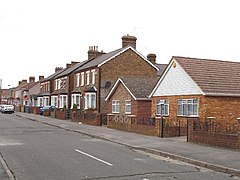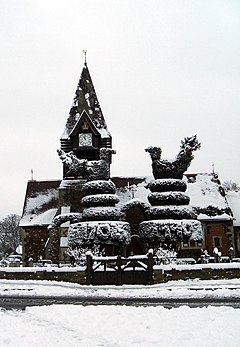East Bedfont
| Bedfont | |
|---|---|
 Street of semi-detached homes and bungalows built like most of the area in the 19th and 20th centuries. |
|
 The modest medieval church in the Church of England has had topiary from its yew trees since 1704. They are today the largest sculpted examples in London. |
|
| Bedfont shown within Greater London | |
| Area | 4.45 km2 (1.72 sq mi) |
| Population | 12,701 ( Bedfont wards 2011) |
| • Density | 2,854/km2 (7,390/sq mi) |
| OS grid reference | TQ0873 |
| Civil parish |
|
| London borough | |
| Ceremonial county | Greater London |
| Region | |
| Country | England |
| Sovereign state | United Kingdom |
| Post town | FELTHAM |
| Postcode district | TW14 |
| Dialling code | 020 |
| Police | Metropolitan |
| Fire | London |
| Ambulance | London |
| EU Parliament | London |
| UK Parliament | |
| London Assembly | |
Bedfont is a suburban district of Hounslow in the historic county of Middlesex, 13 miles (21 km) WSW of Charing Cross and 2 miles (3 km) from Heathrow Airport. It straddles Staines Road (A305) and the River Crane and includes the area informally known as North Feltham and the neighbourhood of Hatton. Its south-western parks and streets are contiguous with the larger district of Feltham, adjoining Feltham railway station on the Waterloo to Reading Line. Bedfont is also served by Hatton Cross tube station on the Piccadilly line. Bedfont has a large central conservation area around Bedfont Green.
Referred to in the Domesday Book as "Bedefunde", the name is thought to be derived from Anglo-Saxon Bedfunta = "Bed’s spring", or Bydenfunta = "spring provided with a drinking-vessel"..
The Staines Road follows the Roman Via Trinobantes colloquially a Stane Street (stone street) linking Londinium (London) to Pontes (Staines-upon-Thames) and the West Country, though the name suggests older origins as the Trinobantes were a powerful Celtic tribe before the Roman invasion. Excavations prior to the building of Heathrow’s Terminal 5 site a few miles north west of Bedfont found evidence of settlement during the Bronze Age, Iron Age and Roman periods, suggesting there may have been people living in and around the Bedfont area during these periods.
...
Wikipedia

